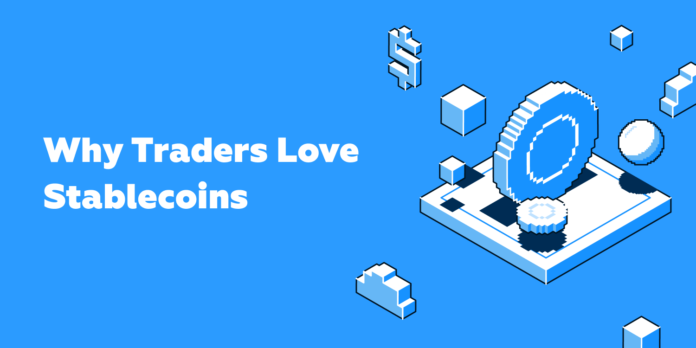
Why Traders Love Stablecoins
A short guide on price-stable cryptocurrencies
Stablecoins are a category of cryptocurrency that’s all pro and no con.
Even those following cryptocurrency at a surface level know the theme that generally dominates this branch of financial technology: it can be extremely volatile. Your $100 holding might soar to $200 overnight, only to be worth $50 when you wake up in the morning. Popular cryptocurrencies get a lot of play as “the future of money,” but until there’s a way to smooth out the volatility that comes with them, and we don’t think they have any mainstream future worth talking about.
That’s why we have to educate the public about stablecoins. This is a distinct category of cryptocurrency boasting all the same technological prowess that won Bitcoin its attention, but it suffers none of the volatile drawbacks. If a stablecoin is pegged to the US dollar, for example, $100 of that stablecoin today will be $100 of stablecoins tomorrow and next week. Stablecoin users get to leverage blockchain technology to its fullest extent without worrying about the value of their digital assets declining.
Stablecoins are built on top of the same blockchain technology driving popular cryptocurrencies like Bitcoin and Ether. Users can conduct transparent peer-to-peer crypto transactions without any middlemen involved. These transactions happen with low fees or none at all, and they’re available for use by anyone, regardless of where they are in the world.
Stability
Stablecoins serve two major purposes. They help make crypto into a more attractive, stable asset, and they enable novel financial instruments. After generating a stable cryptocurrency , you can simply cash it out into fiat if your exchange or remittance service offers that option, but this would ignore some of the passive and active income opportunities these coins enable. Different stablecoin projects have already kickstarted a number of compelling decentralized use cases for loans, risk hedging, and online payments.
That’s why there’s a growing stablecoin market on today’s crypto scene. Research from Diar shows that these coins constitute a $4 billion market cap. The 24-hour trading volume for Tether’s USDT — one of the top USD stablecoins — exceeds Bitcoin’s. The stablecoin market includes other promising names like DAI, EOSDT, and GUSD, among many others. Each works a little differently to protect and preserve its value.
For example, Venezuela launched a stable cryptocurrency in February tied to the price of one barrel of oil. Tether uses fiat collateralization, putting a dollar in the bank for every dollar of crypto it issues (though this is not without major controversy). And so-called “decentralized stablecoins” like Equilibrium’s EOSDT derive their value from the over-collateralization of digital assets.
Decentralized stablecoins are especially compelling. Even though they’re backed by volatile cryptocurrencies, over-collateralization gives users the essential wiggle room to tolerate big dips in collateral value, while the stablecoin value remains unchanged.
Stability protection mechanisms
Stablecoins are supposed to be pegged to a stable source of value, and in many cases this might be a real world asset. So why do their exchange rates change? And how is a stablecoin’s key trait — it’s stability — protected?
Stablecoins can be simultaneously backed (collateralized) by a given asset and pegged to another. Collateralization is about making a deposit to underpin your stablecoin. Centralized stable cryptocurrency architecture relies on fiat money and real word assets, like gold, diamonds, real estate, or other securities. Decentralized stablecoins are about locking up cryptocurrencies like EOS, Bitcoin, or Ether. But every asset has its own price its own markets, and its own accompanying exchanges. This means the price can soar or fall dramatically.
Then we have pegs to a stable fiat currency, like the US dollar or the euro. This peg serves two goals: to give a stablecoin owner a familiar currency reference and to tether the value of a stablecoin with something from the fiat world. Simply put, if your stablecoin costs $1 today it will cost $1 tomorrow. But the value of the dollar itself can increase or decrease depending on the currencies it is traded against.
Despite its steady value. every element of a stablecoin has a price that is changing constantly. Moreover, stablecoin values themselves fluctuate just like fiat currencies do, but their amplitude is much more predictable. In any case, the whole framework helps to prevent a stablecoin owner from losing value to price volatility through mechanisms that rely on demand and supply incentives.
Stablecoins in trading
Stable cryptocurrencies have become popular because they bring steadiness and predictability to an arena that’s mostly known for its unpredictability. Crypto traders saw the daylight first because stablecoins were a way for them to preserve the value of their trades and sleep well at night. If they finished the day with big gains, they could “cash-out” to the stablecoin of their choice, safely converting to a non-volatile currency. If they simply left their positions open across a variety of volatile cryptocurrencies, however, there’s no telling what might happen overnight.
It looks like trading might be the most promising and convenient stablecoin use case, especially for retail investors. Stablecoins play a role across a variety of crypto trading strategies, like margin trading, small spreads trading, pyramiding, arbitrage, and so on. Our next posts will go into detail on how stablecoins can serve you in your trading activities.
***
As the USD peg is most common here, you can basically think of stablecoins as tokenized representations of dollars sitting in a bank. Not only are they popular today, they’ll continue to gain popularity well into the future.
It’s the closest thing to cash the blockchain has ever seen.
[newsletter_form lists="1"]










